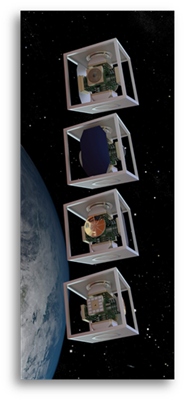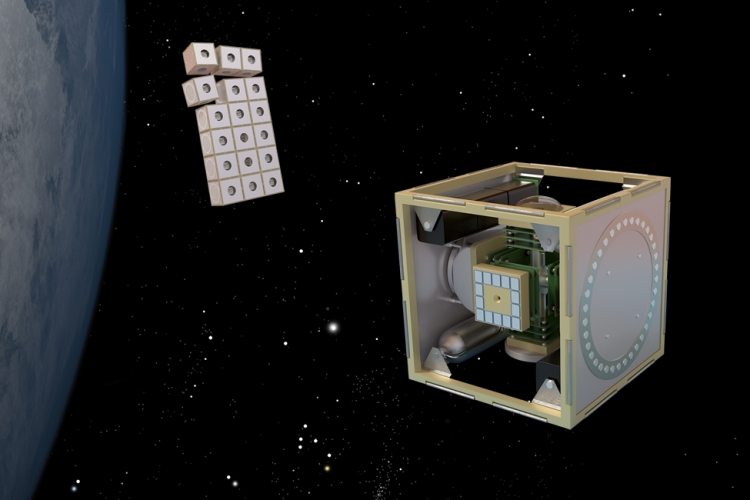Historically, satellites have come in all shapes and sizes. The first satellite, Sputnik 1, was a mere 23 inches in diameter when launched by the Soviet Union on October 4, 1957. In contrast, when the International Space Station was launched in 1998, it was the size of a football field. Today, the most common uses of satellites are for GPS navigation, communications, photography, scientific surveying, and imaging. Generally, most of the satellites currently orbiting in space serve a specific function, although some are capable of performing more than one task.
Satellites are clearly one of our most important space assets due to the important services they perform—to not only make our lives easier, but also for the value they contribute to our national defense. However, because satellites are so important to modern life, there is concern that if a part of a satellite or the entire satellite itself were compromised through malfunctioning or an attack by enemies, this could adversely affect the mission, possibly rendering it useless.
Disaggregation And Resilient Satellite Constellations
In its pursuit to create resilient space, a team of technical experts at The Aerospace Corporation is experimenting with an innovative concept called Hive, a swarm of small satellite units that can not only form structures in space and reconfigure themselves for various tasks, but also be disaggregated when necessary.
Similar to how Legos are assembled, the building block of Hive is a smart, mass-producible, small satellite unit that could interlock with other units and transmit power, data, and heat. Each unit would also be able to rotate on a “face” (one of its sides), while attached to other units as well as climb over other units or detach if necessary. They could also rendezvous, dock, and reconfigure themselves on demand or autonomously.
“This forward-looking technology could enable all kinds of missions with its adaptability, upgradeability, and large physical size,” said team lead Dr. Henry Helvajian. The team’s ultimate goal is to make units that are standardized, interchangeable, and with high reliability. As Helvajian put it, a Hive unit “rolls, hops, and can be swapped.”

Advantages And Applications Of Reconfigurable Satellites
One huge advantage of Hive compared to a traditional satellite is that Hive could change its configuration to perform various missions. For example, Hive could be used as a large, reconfigurable optical telescope, and then by simply moving around key units, it could perform a different function. This adaptability is especially valuable for long-term missions where needs, environmental conditions, and technology may change over time. Another advantage of Hive is that, upon failure of a unit, upgrades would also be easier because malfunctioning or older Hive cells could be individually replaced. And in the event of space threats such as approaching debris, the Hive units could disperse and then reassemble themselves or change their pose after the threat had passed.
Because Hive units are modular and each one is capable of being equipped with a specific function or capability, they can be made to aggregate in space. Consequently, it becomes possible to build very large structures that originally may have been too large to fit on one launch vehicle. Visualizing Hive’s flexibility, Helvajian said, “Hive units could first fly to Mars, where in space, they serve certain functions, but then once on the ground, they can turn into a support structure—for example, a building.”
Aerospace Investigates Building Blocks in Space
So Just How Real Is Hive?

No doubt, the concept of Hive sparks the imagination and all kinds of interesting possibilities come to mind. The Hive team is also definitely thinking outside the box, as well as outside the cube. Instead of making the units out of typical CubeSats—cube-shaped miniature satellites used for space research—they have considered making the Hive unit a circular shape comprised of nested rings. “In trying to figure out the best form factor to allow us to efficiently package and assemble the Hive units, we drew inspiration from a variety of sources, including the slinky toy, origami, molecular chemistry, and even IKEA,” Helvajian said.
Although the idea of Hive is still a work in progress, Helvajian emphasizes that Hive is built on a solid engineering backbone saying, “I didn’t want this to be an exercise in ‘viewchart engineering.’ What stands behind this are 30+ subject matter experts, and the feasibility study stands on reasonable engineering foundations.” He has assembled a broad team of technical specialists from a multitude of scientific areas including distributed software, timing and networks, mechanisms, and thermal and attitude control to investigate the viability of Hive. They are considering new approaches to deployable structures, looking at mechanical and thermal interfaces that enable dynamic configurability, and systematically addressing the multitude of engineering challenges that inevitably arises with ground-breaking ideas like Hive.
As this team of creative engineers continues to investigate and consider different options, they are excited to consider what could ultimately be possible. “Hive is just a forerunner to the changes anticipated as space architecture evolves,” Helvajian said. Although the concept of Hive is ambitious and visionary, as with all innovation, it takes vision and imagination to make the fantastic a reality.
After all, it wasn’t so long ago that traveling to the moon was considered just simply a dream.







